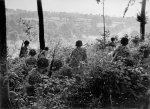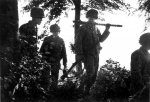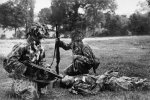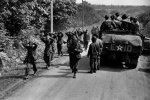IDK how they deployed AAA, but it would be an interesting investigation, worth digging out...I suspect (with no direct knowledge other than how Germans think) that German anticraft guns were layered. The greatest threat to infantry and armor on the front lines was Allied fighter-bombers. So you place anti-aircraft machine guns and smaller (20mm) caliber cannons near the front lines. Further back, where the German had more stationary potential targets (ammo dumps, fuel depots), the Germans would place larger caliber anti-aircraft artillery like the 88mm cannons (I realize there were 88s on/near the front in the anti-tank role, but we're talking AAA).
So, the solution is to bomb from a low altitude, just above 20mm maximum altitude (2200 m), but only just, and, to avoid the larger-caliber antiaircraft cannons that are deeper in German territory, German 88s that were being used in the anti-tank role would be deployed and sighted where they had the best field of fire for shooting Allied tanks, not for shooting aircraft, because the Allies did not use heavy bombers in the ground support role very often (Monte Casino, D-Day, and St. Lo being the only cases I am aware of).
75th anniversary of D-Day...
- Thread starter crimsonaudio
- Start date
- Status
- Not open for further replies.
July 29, 1944: Saturday brings day 5 of Operation Cobra and since yesterday the American troops have made sizable advances (more than 8 miles) deep into the German lines. Three principal points of attack are established: in the west the 3rd Armored division progresses to the south of the town of Coutances, attacked yesterday and liberated today. In the center and the east of the opening, the 2nd Armored division pushes towards Saint-Denis-le-Gest and Villebaudon. The Germans try to create another line connecting the villages of Brehal and Cerences to the west and Percy in the east. - they call this line the "Weisse Linie" (White Line). However, many soldiers belonging to the 84th Corps are surrounded outside the village of Roncey by the 2nd and the 3rd American armoured divisions. Columns of vehicles try to escape from this areas and move towards Coutances but it is too late - three American divisions attack the pocket with massive bombardments. Nearly 1,500 German soldiers are killed and 4,000 more are prisoners. The American forces continue the attack on the German troops and push to attack the "White Line" created by the infantry and Panzer SS divisions. By evening, the American forces in the south reach the villages of Cerences, Cambry, Lengronne, Saint-Denis-le-Gast. The 2nd Armored division moves and attacks towards Percy. The Germans are out-manned, low on supplies, and war-weary, while the American forces are reinforced, well-equipped, and motivated - the rout on the western front of the Battle of Normandy is on.
To the east, near Caen, Canadian 1st Army and British 2nd Army are regrouping for a new offensive in the center of Normandy front.
Over France, RAF Bomber Command sends 119 aircraft to attack a V-weapons site during the day. RAF 2nd Tactical Air Force conducting ground support missions, offensive sorties, and defensive patrols. US 8th Air Force attacks airfields at Laon and Juvincourt-et-Damary with 74 bombers. US 9th Air Force bombers grounded by poor weather conditions, but fighters attack transportation lines and enemy ground positions in support of US 1st Army operations.
Over Germany, US 8th Air Force attacks Merseburg with 568 bombers and RAF Bomber Command sends 30 aircraft to attack Frankfurt overnight.
On the eastern front, the Soviet 3rd Belorussian Front crosses the Niemen River and attacks toward Kaunas. Soviet 1st Baltic Front pushes toward Riga to cut off German 16th Army and 18th Army. Soviet 1st Ukrainian Front crosses the Vistula River at Sandomierz and Soviet 4th Ukrainian Front reforms with 1st Guards Army and 18th Army and inserts into front line between 1st Ukrainian Front and 2nd Ukrainian Front.
In Italy, British 8th Army captures Monte Scalari and pushes toward Empoli. US 12th Air Force bombers grounded by poor weather conditions, but a few fighters attack transportation targets.
Pictured: GIs of the 4th Armored Division guard prisoners during Operation Cobra in Coutances, France on July 29, 1944; US Army convoy passing through the remains of Saint-Lô, France during the Normandy invasion, July 29, 1944; note Jeeps, CCKW 2-1/2 ton transports, Studebaker M29 Weasel, and Dodge WC54 field ambulance; Part of the residential district of Saint-Lô on July 29, 1944. A German command post, thoroughly mined, was found under the cliff on the left.; Gurkhas of 4th Indian Division keep watch on enemy positions in Alpi di Catenaia from high ground on Monte Castiglione, July 29, 1944
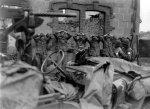
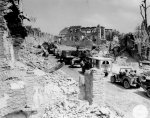
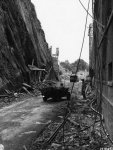
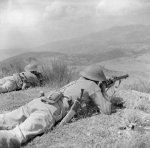
To the east, near Caen, Canadian 1st Army and British 2nd Army are regrouping for a new offensive in the center of Normandy front.
Over France, RAF Bomber Command sends 119 aircraft to attack a V-weapons site during the day. RAF 2nd Tactical Air Force conducting ground support missions, offensive sorties, and defensive patrols. US 8th Air Force attacks airfields at Laon and Juvincourt-et-Damary with 74 bombers. US 9th Air Force bombers grounded by poor weather conditions, but fighters attack transportation lines and enemy ground positions in support of US 1st Army operations.
Over Germany, US 8th Air Force attacks Merseburg with 568 bombers and RAF Bomber Command sends 30 aircraft to attack Frankfurt overnight.
On the eastern front, the Soviet 3rd Belorussian Front crosses the Niemen River and attacks toward Kaunas. Soviet 1st Baltic Front pushes toward Riga to cut off German 16th Army and 18th Army. Soviet 1st Ukrainian Front crosses the Vistula River at Sandomierz and Soviet 4th Ukrainian Front reforms with 1st Guards Army and 18th Army and inserts into front line between 1st Ukrainian Front and 2nd Ukrainian Front.
In Italy, British 8th Army captures Monte Scalari and pushes toward Empoli. US 12th Air Force bombers grounded by poor weather conditions, but a few fighters attack transportation targets.
Pictured: GIs of the 4th Armored Division guard prisoners during Operation Cobra in Coutances, France on July 29, 1944; US Army convoy passing through the remains of Saint-Lô, France during the Normandy invasion, July 29, 1944; note Jeeps, CCKW 2-1/2 ton transports, Studebaker M29 Weasel, and Dodge WC54 field ambulance; Part of the residential district of Saint-Lô on July 29, 1944. A German command post, thoroughly mined, was found under the cliff on the left.; Gurkhas of 4th Indian Division keep watch on enemy positions in Alpi di Catenaia from high ground on Monte Castiglione, July 29, 1944




Indeed, Earle, one good reason was, according to A Brief History of United States Military Camouflage Patterns, "camouflage was barely used in the European campaign as the Axis powers (primarily the German military) were utilizing a variety of camouflage patterns. Concerns arose that issuing camo would cause confusion and friendly fire incidents."Add me to the puzzlement. I have never, ever seen camo in the European theater...
That makes sense. I noticed that a couple of the German POWs are actually smiling.Of course, they seem to be wearing Wehrmacht uniforms, rather than SS, so that may have something to do with it...Indeed, Earle, one good reason was, according to A Brief History of United States Military Camouflage Patterns, "camouflage was barely used in the European campaign as the Axis powers (primarily the German military) were utilizing a variety of camouflage patterns. Concerns arose that issuing camo would cause confusion and friendly fire incidents."
The 2nd and 3rd Armored Divisions were the "heavy" organization. When the U.S. started to build armored divisions, they decided to include around 300 tanks in each armored division. The 1st, 2nd and 3rd Armored Division were built to these specs. After field exercises, the U.S. Army decided that was too many tanks for the division to be agile (this proved true when the 2nd Armored was first committed to battle in Normandy in June 1944; it was so big and cumbersome, it could not get "uncorked."), so they reduced the number of tanks to 162 tanks/division and built the 4th and all subsequent divisions to the newer "lighter" organization.July 29, 1944: Three principal points of attack are established: in the west the 3rd Armored division progresses to the south of the town of Coutances, attacked yesterday and liberated today. In the center and the east of the opening, the 2nd Armored division pushes towards Saint-Denis-le-Gest and Villebaudon. The Germans try to create another line connecting the villages of Brehal and Cerences to the west and Percy in the east. - they call this line the "Weisse Linie" (White Line). However, many soldiers belonging to the 84th Corps are surrounded outside the village of Roncey by the 2nd and the 3rd American armoured divisions.
I mentioned earlier that FDR order the 1st Armored Division stripped of all its tanks and the tanks sent to the Brits in Egypt. When they rebuilt the 1st Armored Division, they rebuilt it to the new light armored division organization. The 2nd and 3rd retained the older heavier organization.
Kids, happy to have survived the war?That makes sense. I noticed that a couple of the German POWs are actually smiling.Of course, they seem to be wearing Wehrmacht uniforms, rather than SS, so that may have something to do with it...
Probably. I'm reminded of what my nextdoor neighbor said years ago, after her escape from Berlin and journey back to southern Swabia. She commented on how happy she was to see the American troops. When I asked why, she looked at me as if I'd said something foolish and said "Because then the bombing would stop"...Kids, happy to have survived the war?
TW —Found a pretty good article on the carpetbombing.
In 1944, U.S. Bombers Blasted Nazi Troops — And Accidentally Killed Scores of Americans
Lt Gen Pete Quesada (one of my heroes; I love that guy) had his 9th TAC Air Force bomb parallel. Bradley, for some reason, expected the heavies to come in parallel, and was angry when they did not.
Now, the Germans had 88mm cannons near the front. The 88 was a great anti-tank gun, but it was designed as an anti-aircraft gun, so not to be taken lightly. The 8th Air Force lost 5 (of 1,800) bombers or 0.3%. I would argue that, not only was bombing parallel more accurate and safer for the ground troops, I would say that flying perpendicular was more dangerous for the aircrews. You cannot just turn around a fleet of 1,800 aircraft on a dime, so they had to go deeper into German-control terrain, thus making them more susceptible to German AAA.
I don’t know Quesada. But I know your depth of knowledge.
Why do you like him so much, and where could I learn more?
Simple view here, but I'd love to hear more from Tidewater: https://en.wikipedia.org/wiki/Elwood_Richard_QuesadaTW —
I don’t know Quesada. But I know your depth of knowledge.
Why do you like him so much, and where could I learn more?
Creative thinker, able to operate beyond his service parochialism.TW —
I don’t know Quesada. But I know your depth of knowledge.
Why do you like him so much, and where could I learn more?
Putting his fighter pilots in the tanks of the breakout forces made airpower effective. As the columns spread out across France, P-47s would fly overhead, conducting aerial recce, and pass info to the armed column, through the Forward Air Controller (FAC). "Hey, there is a village 5 km ahead of the road you're on. Inside the town, I saw a company of infantry and a platoon of Mark IVs. There is a bypass to the north of town, so you can ignore them." That kind of info is invaluable for ground commanders.Innovations attributed to him included ... placing pilots as forward air controllers inside tanks equipped with VHF aircraft radios on the front lines. This latter technique allowed for direct ground communication with overhead fighter-bombers by personnel who understood what pilots needed to identify ground targets. Besides reducing friendly fire incidents, such tactics allowed attacking ground troops to use close air support with greater precision and speed, [and] enormously expanded the contributions of tactical airpower to the Allied defeat of Germany on the Western Front.
On those occasions when the ground guys did want to fight through the ton, the aircraft would provide close air support.
A great American.
Last edited:
Creative thinker, able to operate beyond his service parochialism.
Putting his fighter pilots in the tanks of the breakout forces made airpower effective. As the columns spread out across France, P-47s would fly overhead, conducting aerial reece, and pass info to the armed column, through the Forward Air Controller (FAC). "Hey, there is a village 5 kn ahead of the road you're on. Inside the town, I saw a company of infantry and a platoon of Mark IVs. There is a bypass to the north of town, so you can ignore them." That kind of info is invaluable for ground commanders.
On those occasions when the ground guys did want to fight through the ton, the aircraft would provide close air support.
A great American.
Thanks to both you guys. He does sound like a most interesting fellow. Highly unusual for a man who started out enlisted to rise to that level past all the West Point grads, many of whom stayed in grade for 20+ years in the inter-war period. Talent must have been undeniable. I wonder if pettiness over his lack of academic pedigree and willingness to cross service lines might have cost him a fourth star.Simple view here, but I'd love to hear more from Tidewater: https://en.wikipedia.org/wiki/Elwood_Richard_Quesada
On a tangent, I've always wondered how much trouble (casualties, flawed strategies, unnecessary expenditure of monetary, human and material resources, etc. etc.) the inter-service rivalries, especially among the top brass, might have cost us over the years. Seemed to have been most pronounced in WWII, but I know it continues even today.
Regarding Quesada's post-war life, it sounds as though it was a bit of a roller coaster. A less-than-satisfactory departure from the military, marriage into an internationally-known family, conflicts over children's inheritance of said family's assets, punctuated by positions on meaningful boards of directors and recognition of his contributions.
"Some of it's magic...some of it's tragic...but I had a good life all the way..."
Last edited:
July 30, 1944: The Germans, after quickly forming a defensive line (the Weisse Linie) between Cerences and Percy, are attacked at various points - but the line was formed too quickly and the US troops power through it easily. The Americans continue their offensive to the south (towards Avranches, the ‘entryway’ to Brittany), located about 30 miles south of the starting point of Operation Cobra, which began just one week ago. South of Saint-Lo is now controlled by the 2nd Armored Division and the 30th Infantry Division, which continue to progress to the southeast. In the west, Granville is liberated by the soldiers of the 6th Armored division. The Infantry divisions (4th, 8th and 79th), respectively supported by 3rd, 4th and the 6th armored divisions, attack to the west and liberate Gavray, La Haie-Pesnel, Brehal and Avranches. At the end of the day, the Americans reach the village of Pontaubault in the south and move towards Saint-Hilaire-du-Harcouet. The progression is rapid: the Germans are overwhelmed and retreat without much fight in the face of superior force. The bridge of Pontaubault, which allows access to Brittany, is taken intact and is under American control.
General Patton, chief of the 3rd American Army, is proud of his soldiers - speed was the key of Operation Cobra and things have proceeded as planned. In fact some of the offensives, in particular the liberation of Avranches, have exceeded their wildest hopes. The Allies can now say it: Cobra, despite impressive losses, is a total success. The reports of the losses are as follows: nearly 18,450 American casualties (more than 5,020 KIA) and approximately 15,000 Normans are victims of the bombardments and of the engagements since the beginning of Cobra.
To the east the British, who face two thirds of the German soldiers located in all of Normandy, launch a new operation, dubbed Operation Bluecoat. Six British and Canadians divisions belonging to the 2nd Army (led by General Dempsey) take part in the offensive, which attempts to exploit the German rout generated by Operation Cobra on the eastern side of the American forces. The British attack from Caumont to the east of Vire in the southern area of Villers-Bocage, which is savagely defended by the Western Panzergruppe led by Eberbach and the 7th German Army of Hausser. In response, the 1st and the 9th SS Panzer divisions attack in the east of Caen and weaken the British lines of defense.
Over France, RAF Bomber Command sends 692 aircraft to attack area area around Villers Bocage and Caumont during the day in support of British 2nd Army, with four bombers lost. US 9th Air Force bombers and fighters attack transportation lines and enemy ground positions in support of US 1st Army operations while US 8th Air Force sweeps with 237 fighters. US 9th Air Force utilizes more than 200 transport aircraft for supply and medical evacuation missions.
On the eastern front, Soviet 1st Baltic Front pushes toward Riga to cut off German 16th Army and 18th Army. Soviet 3rd Belorussian Front fights in Kaunas and Soviet 1st Ukrainian Front crosses the Vistula at Baranow.
In Italy, British 8th Army is attacking around Pian dei Cerri. US 12th Air Force aircraft attack targets throughout northern Italy including Ovada, Bistagno, Cherasco, Ferrara, and Savona.
Pictured: A US Soldier seeks cover during an engagement with German forces during Operation Cobra; American soldiers with a group of recently captured German soldiers, near St. Lô. July 30, 1944. ; Tanks of the 2nd Free French Armored Division, part of Patton's 3rd Army, assembled for the exploitation of the break-through during Operation Cobra; A jeep modified to carry two stretchers seen bringing casualties back to a regimental aid post, during Operation ‘Bluecoat’, the offensive south-east of Caumont, July 30, 1944
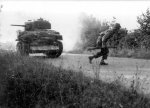

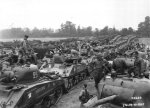
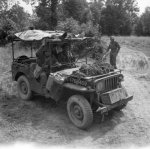
General Patton, chief of the 3rd American Army, is proud of his soldiers - speed was the key of Operation Cobra and things have proceeded as planned. In fact some of the offensives, in particular the liberation of Avranches, have exceeded their wildest hopes. The Allies can now say it: Cobra, despite impressive losses, is a total success. The reports of the losses are as follows: nearly 18,450 American casualties (more than 5,020 KIA) and approximately 15,000 Normans are victims of the bombardments and of the engagements since the beginning of Cobra.
To the east the British, who face two thirds of the German soldiers located in all of Normandy, launch a new operation, dubbed Operation Bluecoat. Six British and Canadians divisions belonging to the 2nd Army (led by General Dempsey) take part in the offensive, which attempts to exploit the German rout generated by Operation Cobra on the eastern side of the American forces. The British attack from Caumont to the east of Vire in the southern area of Villers-Bocage, which is savagely defended by the Western Panzergruppe led by Eberbach and the 7th German Army of Hausser. In response, the 1st and the 9th SS Panzer divisions attack in the east of Caen and weaken the British lines of defense.
Over France, RAF Bomber Command sends 692 aircraft to attack area area around Villers Bocage and Caumont during the day in support of British 2nd Army, with four bombers lost. US 9th Air Force bombers and fighters attack transportation lines and enemy ground positions in support of US 1st Army operations while US 8th Air Force sweeps with 237 fighters. US 9th Air Force utilizes more than 200 transport aircraft for supply and medical evacuation missions.
On the eastern front, Soviet 1st Baltic Front pushes toward Riga to cut off German 16th Army and 18th Army. Soviet 3rd Belorussian Front fights in Kaunas and Soviet 1st Ukrainian Front crosses the Vistula at Baranow.
In Italy, British 8th Army is attacking around Pian dei Cerri. US 12th Air Force aircraft attack targets throughout northern Italy including Ovada, Bistagno, Cherasco, Ferrara, and Savona.
Pictured: A US Soldier seeks cover during an engagement with German forces during Operation Cobra; American soldiers with a group of recently captured German soldiers, near St. Lô. July 30, 1944. ; Tanks of the 2nd Free French Armored Division, part of Patton's 3rd Army, assembled for the exploitation of the break-through during Operation Cobra; A jeep modified to carry two stretchers seen bringing casualties back to a regimental aid post, during Operation ‘Bluecoat’, the offensive south-east of Caumont, July 30, 1944




The photo of the other GIs in the haltrack appear to be from the 2nd Armored Division (1. Notre-Dame-de-Cenilly, the French farmer's hometown, was in 2AD sector. 2. The GIs were riding in a halftrack, which probably means Mechanized Infantry, not regular "straight leg" infantry, who probably would ride, if they rode at all, in 2½ ton trucks.)Pictured: American soldiers with a group of recently captured German soldiers, near St. Lô. July 30, 1944. ;
View attachment 4016
The second group was "near St. Lo," but given the villages Brad said were liberated, the front had progressed well south of St. Lo by 30 July, so "near" might be loosely defined (Gavray, for example, is 37km/23 miles from St. Lo). These GIs could well also be 2AD, so maybe the camo unis were just a testbed for use by the 2AD to see how they worked. And maybe the similarity to Wehrmacht (or SS) camo smocks was such that it led to fratricide, so the 2AD (or whoever was testing them) later ditched them.
I don't ever remember them. I don't even remember them from when Brad posted this series earlier. I ran across this on the site forum.axishistory.com:The photo of the other GIs in the haltrack appear to be from the 2nd Armored Division (1. Notre-Dame-de-Cenilly, the French farmer's hometown, was in 2AD sector. 2. The GIs were riding in a halftrack, which probably means Mechanized Infantry, not regular "straight leg" infantry, who probably would ride, if they rode at all, in 2½ ton trucks.)
The second group was "near St. Lo," but given the villages Brad said were liberated, the front had progressed well south of St. Lo by 30 July, so "near" might be loosely defined (Gavray, for example, is 37km/23 miles from St. Lo). These GIs could well also be 2AD, so maybe the camo unis were just a testbed for use by the 2AD to see how they worked. And maybe the similarity to Wehrmacht (or SS) camo smocks was such that it led to fratricide, so the 2AD (or whoever was testing them) later ditched them.
The "Freikorps Adolf Hitler" is nothing but the quasi-military organization of all these 'bosses', from the
local Ortsgruppenleiter at the bottom to the fat drunken Reichsleiter Ley at the top, whom the Werewolves
disown". While only a few misguided zealots were willing to fight ;on for the Nazi revolution, even fewer
were ready to sacrifice themselves for the sake of Party hacks and local political kingpins who hardly represented the idealistic side of the movement.Freikorpsmanner faced the enemy in Wehrmacht camouflage uniforms and peaked caps, although instructions
stipulated that this uniform was to be quickly discarded in case of a switch-over to partisan activities, and it
is known that female "Freikorps Adolf Hitler" members often carried out reconnaissance missions in civilian clothes.
I'd be curious to see more details about these photos, like where they were taken and when.Rooting around I found a few more:
View attachment 4019
View attachment 4020
View attachment 4021
View attachment 4022
All were taken south of St Lo during Operation Cobra.I'd be curious to see more details about these photos, like where they were taken and when.
I sure would hate to be riding on the stretchers. Goodness that looks shakey.
Does anyone know why there is a mound of dirt on the windshield of the Jeep?
I don't think that's a mound of dirt. It is probably a camouflage net with burlap strips.I sure would hate to be riding on the stretchers. Goodness that looks shakey.
Does anyone know why there is a mound of dirt on the windshield of the Jeep?
- Status
- Not open for further replies.
Latest threads
-
-
Question: Chris Youngblood did he commit over the weekend?
- Started by mlingerfelt31
- Replies: 3
-
-
-
-


